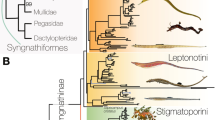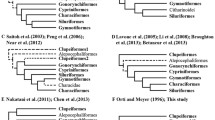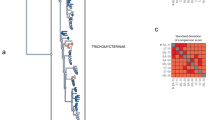Smith WL, Wheeler WC. Venom evolution widespread in fishes: A phylogenetic road map for the bioprospecting of piscine venoms. J Hered. 2006;97(3):206–17.
Article
CAS
PubMed
Google Scholar
Li B, Dettai A, Cruaud C, Couloux A, Desoutter-Meniger M, Lecointre G. RNF213, a new nuclear marker for acanthomorph phylogeny. Mol Phylogen Evol. 2009;50(2):345–63.
Article
CAS
Google Scholar
Near TJ, Dornburg A, Eytan RI, Keck BP, Smith WL, Kuhn KL, Moore JA, Price SA, Burbrink FT, Friedman M, et al. Phylogeny and tempo of diversification in the superradiation of spiny-rayed fishes. Proc Natl Acad Sci U S A. 2013;110(31):12738–43.
Article
CAS
PubMed
PubMed Central
Google Scholar
Betancur-R R, Broughton RE, Wiley EO, Carpenter K, Lopez JA, Li C, Holcroft NI, Arcila D, Sanciangco M, Cureton Ii JC, et al. The tree of life and a new classification of bony fishes. PLoS Curr. 2013; doi:10.1371/currents.tol.53ba26640df0ccaee75bb165c8c26288.
Faircloth BC, Sorenson L, Santini F, Alfaro ME. A phylogenomic perspective on the radiation of ray-finned fishes based upon targeted sequencing of Ultraconserved Elements (UCEs). PLoS One. 2013;8(6):e65923.
Article
CAS
PubMed
PubMed Central
Google Scholar
Phylogenetic Classification of Bony Fishes - Version 3 (http://www.deepfin.org/Classification_v3.htm) Accessed 21 Jan 2016.
Collette BB, Potthoff T, Richards WJ, Ueyanagi S, Russo JL, Nishikawa Y. Scombroidei: development and relationships. In: Moser HG, Richards WJ, Cohen DM, Fahay MP, Kendall AW, Richardson SL, editors. Ontogeny and Systematics of Fishes. Lawrence: American Society of Ichthyologists and Herpetologists; 1984. p. 591–620.
Google Scholar
Kaufman L, Liem KF. Fishes of the suborder Labroidei (Pisces: Perciformes): phylogeny, ecology, and evolutionary significance. Breviora. 1982;472:1–19.
Google Scholar
Orrell TM, Collette BB, Johnson GD. Molecular data support separate scombroid and xiphioid clades. Bull Mar Sci. 2006;79(3):505–19.
Google Scholar
Little AG, Lougheed SC, Moyes CD. Evolutionary affinity of billfishes (**phiidae and Istiophoridae) and flatfishes (Plueronectiformes): Independent and trans-subordinal origins of endothermy in teleost fishes. Mol Phylogen Evol. 2010;56(3):897–904.
Article
CAS
Google Scholar
Wainwright PC, Smith WL, Price SA, Tang KL, Sparks JS, Ferry LA, Kuhn KL, Eytan RI, Near TJ. The evolution of pharyngognathy: a phylogenetic and functional appraisal of the pharyngeal jaw key innovation in labroid fishes and beyond. Syst Biol. 2012;61(6):1001–27.
Article
PubMed
Google Scholar
Smith WL, Craig MT. Casting the percomorph net widely: the importance of broad taxonomic sampling in the search for the placement of serranid and percid fishes. Copeia. 2007;2007:35–55.
Article
Google Scholar
Miya M, Takeshima H, Endo H, Ishiguro NB, Inoue JG, Mukai T, Satoh TP, Yamaguchi M, Kawaguchi A, Mabuchi K, et al. Major perspectives of higher teleostean phylogenies: a new perspective based on 100 complete mitochondrial DNA sequences. Mol Phylogen Evol. 2003;26:121–38.
Article
CAS
Google Scholar
Chen WJ, Bonillo C, Lecointre G. Repeatability of clades as a criterion of reliability: a case study for molecular phylogeny of Acanthomorpha (Teleostei) with larger number of taxa. Mol Phylogen Evol. 2003;26(2):262–88.
Article
CAS
Google Scholar
Betancur-R R, Li C, Munroe TA, Ballesteros JA, Ortí G. Addressing gene tree discordance and non-stationarity to resolve a multi-locus phylogeny of the flatfishes (Teleostei: Pleuronectiformes). Syst Biol. 2013;62(5):763–85.
Article
PubMed
Google Scholar
Block BA, Finnerty JR. Endothermy in fishes: a phylogenetic analysis of constraints, predispositions, and selection pressures. Environ Biol Fishes. 1994;40:283–302.
Article
Google Scholar
Friedman M, Johanson Z, Harrington RC, Near TJ, Graham MR. An early fossil remora (Echeneoidea) reveals the evolutionary assembly of the adhesion disc. Proc R Soc Lond [Biol]. 2013;280(1766):20131200.
Article
Google Scholar
O’Toole B. Phylogeny of the species of the superfamily Echeneoidea (Perciformes : Carangoidei: Echeneidae, Rachycentridae, and Coryphaenidae), with an interpretation of echeneid hitchhiking behaviour. Can J Zool-Rev Can Zool. 2002;80(4):596–623.
Article
Google Scholar
Motomura H, Sado T, Kimura S. Feeding behaviour of Polydactylus plebeius (Perciformes: Polynemidae) in an aquarium. Jap J Ichthyol. 2002;49:156–7.
Google Scholar
Halstead BW, Danielson DD, Baldwin WJ, Engen PC. Morphology of the venom apparatus of the leatherback fish Scomberoides sanctipetri(Cuvier). Toxicon. 1972;10(3):249–58.
Article
CAS
PubMed
Google Scholar
Timmermans PJ. Prey catching in the archer fish: marksmanship, and endurance of squirting at an aerial target. Neth J Zool. 2000;50:411–23.
Article
Google Scholar
Norman JR. A systematic monograph of the flatfishes (Heterostomata), Vol. 1 Psettodidae, Bothidae, Pleuronectidae. London: Printed by the order of the Trustees of the British Museum; 1934.
Book
Google Scholar
Hubbs CL. Phylogenetic position of the Citharidae, a family of flatfishes. Miscellaneous Publications Museum of Zoology, University of Michigan. 1945;63:1–38.
Google Scholar
Lauder GV, Liem KF. The evolution and interrelationships of the actinopterygian fishes. Bull Mus Comp Zool. 1983;150(3):95–197.
Google Scholar
Hensley DA, Ahlstrom EH. Pleuronectiformes: relationships. In: Moser H, Richards WJ, Cohen DM, Fahay MP, Kendall AW, Richardson SL, editors. Ontogeny and Sytematics of Fishes. Lawrence: American Society of Ichthyologists and Herpetologists; 1984. p. 670–87.
Google Scholar
Chapleau F. Pleuronectiform relationships: A cladistic reassessment. Bull Mar Sci. 1993;52(1):516–40.
Google Scholar
Wiley EO, Johnson GD. A teleost classification based on monophyletic groups. In: Nelson JS, Schultze H-P, Wilson MVH, editors. Origin and phylogenetic interrelationships of teleosts. Munchen: Verlag Dr. Friedrich Pfeil; 2010. p. 123–82.
Google Scholar
Friedman M. The evolutionary origin of flatfish asymmetry. Nature. 2008;454(7201):209–12.
Article
CAS
PubMed
Google Scholar
Friedman M. Explosive morphological diversification of spiny-finned teleost fishes in the aftermath of the end-Cretaceous extinction. Proc R Soc Lond [Biol]. 2010;277(1688):1675–83.
Article
Google Scholar
Regan CT. The origin and evolution of the teleostean fishes of the order Heterosomata. Ann Mag Nat Hist. 1910;6(8):484–96.
Article
Google Scholar
Kyle HM. The asymmetry, metamorphosis and origin of flat-fishes. Philos Trans R Soc London [Biol]. 1921;211:75–128.
Article
Google Scholar
Chabanaud P. Le problem de la phylogenése des Heterostomata. Bull Inst Océanogr Monaco. 1949;950:1–24.
Google Scholar
Amaoka K. Studies on the sinistral flounders found in the waters around Japan. Taxonomy, anatomy and phylogeny. J Shimonoseki Univ Fish. 1969;18:65–340.
Google Scholar
Betancur-R R, Ortí G. Molecular evidence for the monophyly of flatfishes (Carangimorpharia: Pleuronectiformes). Mol Phylogen Evol. 2014;73:18–22.
Article
Google Scholar
Campbell M, Lopez JA, Satoh TP, Chen WJ, Miya M. Mitochondrial genomic investigation of flatfish monophyly. Gene. 2014;551:176–82.
Article
CAS
PubMed
Google Scholar
Sanciangco MD, Carpenter KE, Betancur-R R. Phylogenetic placement of enigmatic percomorph families (Teleostei: Percomorphaceae). Mol Phylogen Evol. 2016;94:565–76.
Article
Google Scholar
Chanet B. A cladistic reappraisal of the fossil flatfishes record consequences on the phylogeny of the Pleuronectiformes (Osteichthyes: Teleostei). Ann Sci Nat. 1997;18:105–16.
Google Scholar
Campbell MA, Chen WJ, Lopez JA. Are flatfishes (Pleuronectiformes) monophyletic? Mol Phylogen Evol. 2013;69(3):664–73.
Article
Google Scholar
Campbell MA, Chen WJ, Lopez JA. Molecular data do not provide unambiguous support for the monophyly of flatfishes (Pleuronectiformes): a reply to Betancur-R and Ortí. Mol Phylogen Evol. 2014;75:149–53.
Article
Google Scholar
Foster PG, Hickey DA. Compositional bias may affect both DNA-based and protein-based phylogenetic reconstructions. J Mol Evol. 1999;48(3):284–90.
Article
CAS
PubMed
Google Scholar
Felsenstein J. Cases in Which Parsimony or Compatibility Methods Will Be Positively Misleading. Syst Zool. 1978;27(4):401–10.
Article
Google Scholar
Anderson FE, Swofford DL. Should we be worried about long-branch attraction in real data sets? Investigations using metazoan 18S rDNA. Mol Phylogen Evol. 2004;33(2):440–51.
Article
CAS
Google Scholar
Maddison WP. Gene trees in species trees. Syst Biol. 1997;46(3):523–36.
Article
Google Scholar
Edwards SV, Liu L, Pearl DK. High-resolution species trees without concatenation. Proc Natl Acad Sci U S A. 2007;104(14):5936–41.
Article
CAS
PubMed
PubMed Central
Google Scholar
Kubatko LS. Identifying hybridization events in the presence of coalescence via Model selection. Syst Biol. 2009;58(5):478–88.
Article
CAS
PubMed
Google Scholar
Degnan JH, Rosenberg NA. Discordance of species trees with their most likely gene trees. PLoS Genet. 2006;2(5):762–8.
Article
CAS
Google Scholar
Maddison WP, Knowles LL. Inferring phylogeny despite incomplete lineage sorting. Syst Biol. 2006;55(1):21–30.
Article
PubMed
Google Scholar
McGee MD, Faircloth BC, Borstein SR, Zheng J, Hulsey CD, Wainwright PC, Alfaro ME. Replicated divergence in cichlid radiations mirrors a major vertebrate innovation. P Roy Soc B-Biol Sci. 2016;283(1822).
Gilbert PS, Chang J, Pan C, Sobel EM, Sinsheimer JS, Faircloth BC, Alfaro ME. Genome-wide ultraconserved elements exhibit higher phylogenetic informativeness than traditional gene markers in percomorph fishes. Mol Phylogenet Evol. 2015;92:140–6.
Article
PubMed
PubMed Central
Google Scholar
Hosner PA, Faircloth BC, Glenn TC, Braun EL, Kimball RT. Avoiding missing data biases in phylogenomic inference: an empirical study in the landfowl (Aves: Galliformes). Mol Biol Evol. 2016;33(4):1110–25.
Article
CAS
PubMed
Google Scholar
Streicher JW, Schulte 2nd JA, Wiens JJ. How should genes and taxa be sampled for phylogenomic analyses with missing data? An empirical study in iguanian lizards. Syst Biol. 2016;65(1):128–45.
Article
PubMed
Google Scholar
Stamatakis A. RAxML-VI-HPC: Maximum likelihood-based phylogenetic analyses with thousands of taxa and mixed models. Bioinformatics. 2006;22(21):2688–90.
Article
CAS
PubMed
Google Scholar
Lanfear R, Calcott B, Ho SY, Guindon S. Partitionfinder: combined selection of partitioning schemes and substitution models for phylogenetic analyses. Mol Biol Evol. 2012;29(6):1695–701.
Article
CAS
PubMed
Google Scholar
Lanfear R, Calcott B, Kainer D, Mayer C, Stamatakis A. Selecting optimal partitioning schemes for phylogenomic datasets. BMC Evol Biol. 2014;14.
Aberer AJ, Kobert K, Stamatakis A. ExaBayes: massively parallel Bayesian tree inference for the whole-genome era. Mol Biol Evol. 2014;31(10):2553–6.
Article
CAS
PubMed
PubMed Central
Google Scholar
Rambaut A, Suchard MA, **e D, Drummond AJ: Tracer v1.6. In.: Available from http://beast.bio.ed.ac.uk/Tracer; 2014.
Mirarab S, Reaz R, Bayzid MS, Zimmermann T, Swenson MS, Warnow T. ASTRAL: genome-scale coalescent-based species tree estimation. Bioinformatics. 2014;30(17):i541–8.
Article
CAS
PubMed
PubMed Central
Google Scholar
Kubatko LS, Degnan JH. Inconsistency of phylogenetic estimates from concatenated data under coalescence. Syst Biol. 2007;56(1):17–24.
Article
CAS
PubMed
Google Scholar
Ane C, Larget B, Baum DA, Smith SD, Rokas A. Bayesian estimation of concordance among gene trees. Mol Biol Evol. 2007;24(2):412–26.
Article
CAS
PubMed
Google Scholar
Larget BR, Kotha SK, Dewey CN, Ane C. BUCKy: gene tree/species tree reconciliation with Bayesian concordance analysis. Bioinformatics. 2010;26(22):2910–1.
Article
CAS
PubMed
Google Scholar
Degnan JH, DeGiorgio M, Bryant D, Rosenberg NA. Properties of consensus methods for inferring species trees from gene trees. Syst Biol. 2009;58(1):35–54.
Article
PubMed
PubMed Central
Google Scholar
Ronquist F, Teslenko M, van der Mark P, Ayres DL, Darling A, Hohna S, Larget B, Liu L, Suchard MA, Huelsenbeck JP. MrBayes 3.2: efficient Bayesian phylogenetic inference and model choice across a large model space. Syst Biol. 2012;61(3):539–42.
Article
PubMed
PubMed Central
Google Scholar
Drummond AJ, Suchard MA, **e D, Rambaut A. Bayesian phylogenetics with BEAUti and the BEAST 1.7. Mol Biol Evol. 2012;29(8):1969–73.
Article
CAS
PubMed
PubMed Central
Google Scholar
Yang ZH. PAML 4: Phylogenetic analysis by maximum likelihood. Mol Biol Evol. 2007;24(8):1586–91.
Article
CAS
PubMed
Google Scholar
Hedman MM. Constraints on clade ages from fossil outgroups. Paleobiology. 2010;36:16–31.
Article
Google Scholar
Paradis E, Claude J, Strimmer K. APE: Analyses of phylogenetics and evolution in R language. Bioinformatics. 2004;20(2):289–90.
Article
CAS
PubMed
Google Scholar
Sukumaran J, Holder MT. DendroPy: a Python library for phylogenetic computing. Bioinformatics. 2010;26(12):1569–71.
Article
CAS
PubMed
Google Scholar
Gatesy J, Springer MS. Phylogenetic analysis at deep timescales: Unreliable gene trees, bypassed hidden support, and the coalescence/concatalescence conundrum. Mol Phylogen Evol. 2014;80:231–66.
Article
Google Scholar
Edwards SV, ** ZX, Janke A, Faircloth BC, McCormack JE, Glenn TC, Zhong BJ, Wu SY, Lemmon EM, Lemmon AR, et al. Implementing and testing the multispecies coalescent model: A valuable paradigm for phylogenomics. Mol Phylogen Evol. 2016;94:447–62.
Article
Google Scholar
Hoshino K. Monophyly of the Citharidae (Pleuronectoidei: Pleuronectiformes: Teleostei) with considerations of pleuronectid phylogeny. Ichthyol Res. 2001;48:391–404.
Article
Google Scholar
Friedman M. Osteology of †Heteronectes chaneti (Acanthomorpha, Pleuronectiformes), an Eocene stem flatfish, with a discussion of flatfish sister-group relationships. J Vert Paleontol. 2012;32:735–56.
Article
Google Scholar
Freihofer WC. Cranial nerves of a percoid fish, Polycentrus schomburgkii (Family Nandidae), a contribution to the morphology and classification of the order Perciformes. Occas Pap, Calif Acad Sci. 1978;128:1–78.
Google Scholar
Johnson GD. Percoidei: development and relationships. In: Moser HG, Richards WJ, Cohen DM, Fahay MP, Kendall AW, Richardson SL, editors. Ontogeny and Systematics of Fishes. Lawrence: American Society of Ichthyologists and Herpetologists; 1984. p. 464–98.
Google Scholar
Miya M, Friedman M, Satoh TP, Takeshima H, Sado T, Iwasaki W, Yamanoue Y, Nakatani M, Mabuchi K, Inoue JG, et al. Evolutionary origin of the Scombridae (tunas and mackerels): members of a paleogene adaptive radiation with 14 other pelagic fish families. PLoS One. 2013;8(9):e73535.
Article
CAS
PubMed
PubMed Central
Google Scholar
Johnson GD. Scombroid phylogeny: an alternative hypothesis. Bull Mar Sci. 1986;39:1–41.
Google Scholar
Fraser TH. Comparative osteology of the Atlantic snooks (Pisces, Centropomus). Copeia. 1968;1968:433–60.
Article
Google Scholar
Greenwood PH. A review of the family Centropomidae (Pisces, Perciformes). Bull Br Mus Nat Hist (Zool). 1976;29:1–81.
Google Scholar
Li C, Betancur-R R, Smith WL, Ortí G. Monophyly and interrelationships of Snook and Barramundi (Centropomidae sensu Greenwood) and five new markers for fish phylogenetics. Mol Phylogen Evol. 2011;60(3):463–71.
Article
Google Scholar
Santini F, Carnevale G. First multilocus and densely sampled timetree of trevallies, pompanos and allies (Carangoidei, Percomorpha) suggests a Cretaceous origin and Eocene radiation of a major clade of piscivores. Mol Phylogen Evol. 2015;83:33–9.
Article
Google Scholar
Patterson C. Osteichthyes: Teleostei. In: Benton MJ, editor. The Fossil Record 2. London: Chapman & Hall; 1993. p. 621–56.
Google Scholar
Friedman M, Johnson GD. A new species of Mene (Perciformes: Menidae) from the Paleocene of South America, with notes on the paleoenvironment and a brief review of menid fishes. J Vert Paleontol. 2005;25:770–83.
Article
Google Scholar
Friedman M, Johanson Z, Harrington RC, Near TJ, Graham MR. On fossils, phylogenies and sequences of evolutionary change. Proc R Soc Lond [Biol]. 2014;281:20140115.
Article
Google Scholar
Micklich N, Gregorová R, Bannikov AF, Baciu DS, Grădianu I, Carnevale G. Oligoremora rhenana n. g. n. sp., a new echeneid fish (Percomorpha, Echeneoidei) from the Oligocene of the Grube Unterfeld (“Frauenweiler”) clay pit. PalZ. 2016;90:561-92.
Darwin C. On the Origin of Species by Means of Natural Selection. 6th ed. London: John Murray; 1872.
Google Scholar
Schwarzhans W. A comparative morphological treatise of recent and fossil otoliths of the family Sciaenidae (Perciformes). Verlag F. Pfeil: München; 1993.
Google Scholar
Mooi RD, Gill AC. Association of epaxial musculature with dorsal-fin pterygiophores in acanthomorph fishes, and its phylogenetic significance. Bull Br Mus Nat Hist (Zool). 1995;61:121–37.
Google Scholar
Fukada E, Nakae M, Asoaoka R, Sasaki K. Branching patterns of trunk lateral line nerves in Pleuronectiformes: uniformity and diversity. Ichthyol Res. 2010;57:148–60.
Article
Google Scholar
Nakamura I. Systematics of the billfishes (**phiidae and Istiophoridae). Publ Seto Mar Biol Lab. 1983;28:255–396.
Google Scholar
Woodland DJ. Menidae. In: Carpenter KE, Niem V, editors. The Living Marine Resources of the Western Central Pacific. 5th ed. Rome: FAO; 2001. p. 2971.
Google Scholar
Tominaga Y. The internal morphology and systematic position of Leptobrama mülleri, formerly included in the family Pempheridae. Jap J Ichthyol. 1965;12:33–56.
Google Scholar
Leis JM. Larvae, adults and relationships of the monotypic perciform fish family Lactariidae. Rec Aust Mus. 1994;46:131–43.
Article
Google Scholar
Baldwin CC. The phylogenetic significance of colour patterns in marine teleost larvae. Zool J Linn Soc. 2013;168(3):496–563.
Article
PubMed
PubMed Central
Google Scholar
Friedman M, Keck BP, Dornburg A, Eytan RI, Martin CH, Hulsey CD, Wainwright PC, Near TJ. Molecular and fossil evidence place the origin of cichlid fishes long after Gondwanan rifting. Proc R Soc Lond [Biol]. 2013;289:20121733.
Google Scholar
Kocher TD. Adaptive evolution and explosive speciation: the cichlid fish model. Nature Rev Genet. 2004;5:288–98.
Article
CAS
PubMed
Google Scholar
Stewart TA, Albertson RC. Evolution of a unique predatory feeding apparatus: functional anatomy, development and a genetic locus for jaw laterality in Lake Tanganyika scale-eating cichlids. BMC Biol. 2010;8:8.
Article
PubMed
PubMed Central
Google Scholar
Gatesy J, Geisler JH, Chang J, Buell C, Berta A, Meredith RW, Springer MS, McGowen MR. A phylogenetic blueprint for a modern whale. Mol Phylogen Evol. 2013;66:479–506.
Article
Google Scholar
Simpson GG. Tempo and Mode in Evolution. New York: Columbia University Press; 1944.
Google Scholar
Schluter D. Ecological speciation in postglacial fishes. Philos Trans R Soc London [Biol]. 1996;351:807–14.
Article
Google Scholar
Schluter D. Adaptive radiation in sticklebacks - size, shape, and habitat use efficiency. Ecology. 1993;74(3):699–709.
Article
Google Scholar
Sato A, Tichy H, O’HUigin C, Grant PR, Grant BR, Klein J. On the origin of Darwin’s finches. Mol Biol Evol. 2001;18(3):299–311.
Article
CAS
PubMed
Google Scholar
Near TJ, Dornburg A, Kuhn KL, Eastman JT, Pennington JN, Patarnello T, Zane L, Fernandez DA, Jones CD. Ancient climate change, antifreeze, and the evolutionary diversification of Antarctic fishes. Proc Natl Acad Sci U S A. 2012;109(9):3434–9.
Article
CAS
PubMed
PubMed Central
Google Scholar
Wagner CE, Harmon LJ, Seehausen O. Ecological opportunity and sexual selection together predict adaptive radiation. Nature. 2012;487(7407):366–9.
Article
CAS
PubMed
Google Scholar
Harrington RC, Faircloth BC, Eytan RI, Smith WL, Near TJ, Alfaro ME, Friedman M. Data from: Phylogenomic analysis of carangimorph fishes reveals flatfish asymmetry arose in a blink of the evolutionary eye. 2016. Dryad Digital Repository, http://dx.doi.org/105061/dryad2fj55.
Google Scholar






